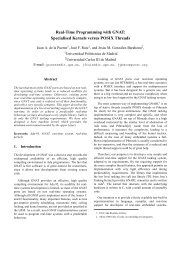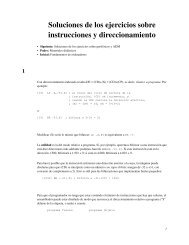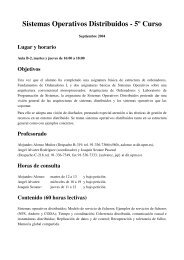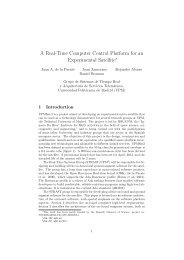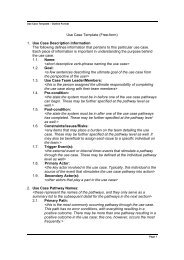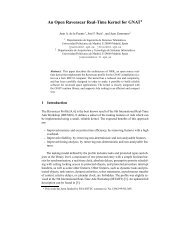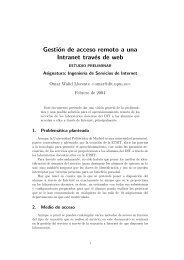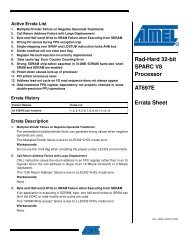Lab Proposal for Integrated Real-time and Control - DCS - UPC
Lab Proposal for Integrated Real-time and Control - DCS - UPC
Lab Proposal for Integrated Real-time and Control - DCS - UPC
You also want an ePaper? Increase the reach of your titles
YUMPU automatically turns print PDFs into web optimized ePapers that Google loves.
6(a) Fast closed loop response(a) Setup(b) Overshoot closed loop response(b) Open loop responseFig. 7.RCRC responses.Fig. 6.Experiment setup <strong>and</strong> monitoring.execution <strong>time</strong> of 9 ms. The noisy task that goes together withthe overshoot controller has a period <strong>and</strong> relative deadline of110 ms with 90 ms of execution <strong>time</strong>. The simulation of eachmultitasking system was done in the TrueTime simulator [32].Putting together each control task with the corresponding noisytask under EDF results in timing variability (jitter) <strong>for</strong> thecontrol task, as illustrated <strong>for</strong> the first multitasking system inthe schedule of Figure 8a. In this figure, the bottom curverepresents the execution of the fast controller task, whereasthe top curve represents the execution of the noisy task. Ineach graph, the low-level line denotes no-execution (that is,intervals in which the processor is idle), the middle level linedenotes a task ready to execute (i.e., waiting in the readyqueue), whereas the high-level line denotes a task in execution.Note that the control task has a measured execution <strong>time</strong> of0.12 ms, which is much less than the noisy task.Looking at the plant responses in Figures 8 b) <strong>and</strong> c), it canbe appreciated that the fast controller does not exhibit a controlper<strong>for</strong>mance degradation, while the overshoot controller sufferssome degradation: overshoots are bigger, square amplitudediffers, transient response varies, etc. This fact indicates thatthe current control design <strong>for</strong> the fast controller is robustagainst jitters induced by scheduling, while the second oneis more fragile.Observation 10: Adopting an iterative simulation study,students can learn which parameters play an important rolewhen jitters appear. Are shorter sampling periods, or nonovershoottedresponses, a guarantee <strong>for</strong> having robust controldesigns? Which role do deadlines play in reducing jitters? Forfurther questions <strong>and</strong> solutions, see [33] <strong>and</strong> references therein.K. Problem 11. Multitasking: implementation <strong>and</strong> monitoringdetailsThe new implementation requires specifying the noisy taskby modifying the kernel oil file in terms of defining thenew task <strong>and</strong> the associated alarm. Also, the new task hasto be coded: <strong>for</strong>cing an artificial execution <strong>time</strong> is achievedby placing a delay into the code. The main code has to bemodified to configure the new alarm associated to the newtask.After the implementation, in the first multitasking system,it can be verified that scheduling conflicts (as illustrated inthe simulated schedule shown in Figure 8a) may occur, asillustrated in Figure 9a. In this sub-figure, the execution ofthe fast controller task sets an output pin to 0 <strong>and</strong> 1 ateach job start <strong>and</strong> finishing <strong>time</strong>. And the noisy task setsan output pin to 0 <strong>and</strong> 0.5 at each job start <strong>and</strong> finishing<strong>time</strong>. In addition, similar responses <strong>for</strong> the fast <strong>and</strong> overshootcontroller are obtained (see sub-figures 9 b) <strong>and</strong> c)), showingthat the overshoot controller suffers degradation from jitters,while the fast controller shows the same response as it isexecuted in isolation. To illustrative purposes, Figure 10ashows the overshoot controller response when executing inisolation (dark curve) <strong>and</strong> when executing in the multitaskingsystem (grey curve).Observation 11: Undergraduate students may work the experimentup to this problem. It shows the importance of



